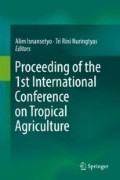Abstract
This study was conducted to evaluate the effect of different saponification and aldehyde protection for polyunsaturated fatty acid derived from soybean groats and lemuru fish oil in the beef cattle diet on the characteristics of in vivo fermentation kinetics. Three fistulated cows were used for in vivo treatment. Lemuru fish oil was protected by saponification with 2.0% Ca salt and 2.0% soybean groats protected by aldehyde solution. Experimental design was 3 × 3 latin squares, R1 (control feed), R2 (R1 + 10% PUFA saponification protected), and R3 (R1 + 10% PUFA aldehyde protected). Measurement of ration fermentability was conducted in a specified time to determine the ruminal kinetics 0 h, 3 h, 6 h, 9 h, 12 h, and 24 h after feeding. Research parameters include rumen fermentation (pH, VFA, and microbial protein) and digestibility (dry matter, organic matter, and crude protein). The results of the study indicate that differences in treatment have no significant effect (p > 0.05) on dry matter, organic matter, and crude protein. The use of PUFA of lemuru fish oil protected by saponification and soya groats protected by aldehyde as supplements added to cattle feed rations in vivo provides good fermentation characteristics in creating rumen ecology in accordance with the rumen microbe needs. It can be concluded that saponification and aldehyde are effective for PUFA protection and can be used up to the level of 10% in the composition of beef cattle rations.
Access this chapter
Tax calculation will be finalised at checkout
Purchases are for personal use only
References
Jenkins, T.C.: Lipid metabolism in the rumen. J. Dairy Sci. 76, 3851–3863 (1993)
Wallace, J.M.W., et al.: Bioavailability of n-3 polyunsaturated fatty acids (PUFA) in foods enriched with microencapsulated fish oil. Ann. Nut. Met. 44, 157–162 (2000)
Riyanto, J., et al.: Supplementation with PUFA (poly unsaturated fatty acid) in concentrate from the local feed ingredients in Feedlot cattle business crosses of rice straw basal diet based on fermentation to produce beef low in fat and cholesterol and high in unsaturated fatty acids. Research report, Ministry of National Education (2011)
Mohammadian-Tabrizi., et al.: In vitro gas production of wheat grain flour coated with different fat types and levels. Afr. J. Biotechnol. 10, 7710–7716 (2011)
Lourenc, M., et al.: The role of microbes in rumen lipolysis and biohydrogenation and their manipulation. J. Anim. Sci. 4, 1008–1023 (2010)
Dirandeh, E., et al.: Effects of different polyunsaturated fatty acid supplementations during the postpartum periods of early lactating dairy cows on milk yield, metabolic responses, and reproductive performances. J. Anim. Sci. 91, 713–721 (2013)
Lopes, C.N., et al.: Effects of rumen-protected polyunsaturated fatty acid supplementation on reproductive performance of Bos indicus beef cows. J. Anim. Sci. 87, 3935–3943 (2009)
McDonald, P., et al.: Animal Nutrition, 4th edn. Longman, London (2002)
Doreau, M., Chilliard, Y.: Digestion and metabolism of dietary fat in farm animals. Br. J. Nutr. 78, S15–S35 (1997)
Johnson, M.C.: Understanding Rumen Fermentation: I. Effect of high DHA Algal oil on microbial biohydrogenation and II. Monitoring microbial shifts in response to antibiotics and oil using T-RFLP analysis. Thesis, North Carolina State University (2007)
Schrooyen, P.M.M., et al.: Microencapsulation: its application in nutrition. Proc. Nutr. Soc. 60, 475–479 (2001)
Nobar, R.S.: Ruminal dry matter degradability of treated soybean meal as source of escape protein. African J. Biotech. 10, 8090–8092 (2011)
Stanton, T.L., et al.: Formaldehyde-treated soybean meal for ruminants grazing winter range grass. J. Anim. Sci. 56, 6–14 (1983)
Author information
Authors and Affiliations
Corresponding author
Editor information
Editors and Affiliations
Rights and permissions
Copyright information
© 2017 Springer International Publishing AG
About this paper
Cite this paper
Riyanto, J., Sudibya (2017). Characteristics of Fermentation Kinetics and Digestibility of PUFA Saponification and Aldehyde Protected as Cattle Feed Supplement In Vivo . In: Isnansetyo, A., Nuringtyas, T. (eds) Proceeding of the 1st International Conference on Tropical Agriculture. Springer, Cham. https://doi.org/10.1007/978-3-319-60363-6_38
Download citation
DOI: https://doi.org/10.1007/978-3-319-60363-6_38
Published:
Publisher Name: Springer, Cham
Print ISBN: 978-3-319-60362-9
Online ISBN: 978-3-319-60363-6
eBook Packages: Biomedical and Life SciencesBiomedical and Life Sciences (R0)

